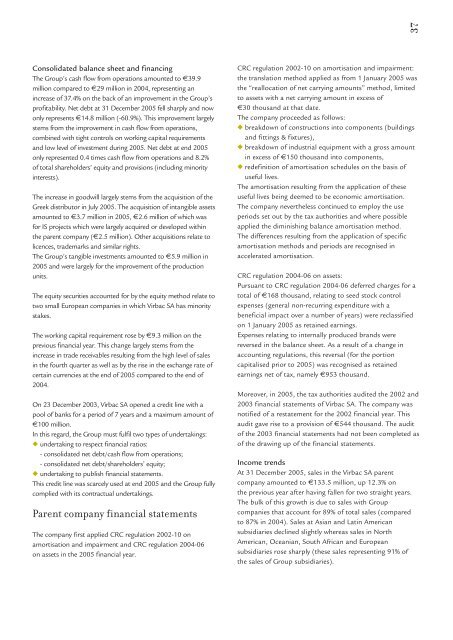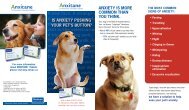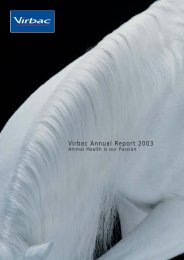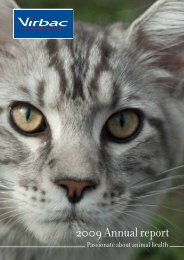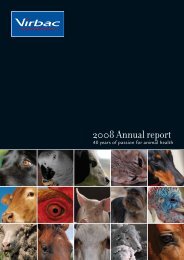2005 Annual report - Virbac
2005 Annual report - Virbac
2005 Annual report - Virbac
You also want an ePaper? Increase the reach of your titles
YUMPU automatically turns print PDFs into web optimized ePapers that Google loves.
37<br />
Consolidated balance sheet and financing<br />
The Group’s cash flow from operations amounted to €39.9<br />
million compared to €29 million in 2004, representing an<br />
increase of 37.4% on the back of an improvement in the Group’s<br />
profitability. Net debt at 31 December <strong>2005</strong> fell sharply and now<br />
only represents €14.8 million (-60.9%). This improvement largely<br />
stems from the improvement in cash flow from operations,<br />
combined with tight controls on working capital requirements<br />
and low level of investment during <strong>2005</strong>. Net debt at end <strong>2005</strong><br />
only represented 0.4 times cash flow from operations and 8.2%<br />
of total shareholders’ equity and provisions (including minority<br />
interests).<br />
The increase in goodwill largely stems from the acquisition of the<br />
Greek distributor in July <strong>2005</strong>. The acquisition of intangible assets<br />
amounted to €3.7 million in <strong>2005</strong>, €2.6 million of which was<br />
for IS projects which were largely acquired or developed within<br />
the parent company (€2.5 million). Other acquisitions relate to<br />
licences, trademarks and similar rights.<br />
The Group’s tangible investments amounted to €5.9 million in<br />
<strong>2005</strong> and were largely for the improvement of the production<br />
units.<br />
The equity securities accounted for by the equity method relate to<br />
two small European companies in which <strong>Virbac</strong> SA has minority<br />
stakes.<br />
The working capital requirement rose by €9.3 million on the<br />
previous financial year. This change largely stems from the<br />
increase in trade receivables resulting from the high level of sales<br />
in the fourth quarter as well as by the rise in the exchange rate of<br />
certain currencies at the end of <strong>2005</strong> compared to the end of<br />
2004.<br />
On 23 December 2003, <strong>Virbac</strong> SA opened a credit line with a<br />
pool of banks for a period of 7 years and a maximum amount of<br />
€100 million.<br />
In this regard, the Group must fulfil two types of undertakings:<br />
◆ undertaking to respect financial ratios:<br />
- consolidated net debt/cash flow from operations;<br />
- consolidated net debt/shareholders’ equity;<br />
◆ undertaking to publish financial statements.<br />
This credit line was scarcely used at end <strong>2005</strong> and the Group fully<br />
complied with its contractual undertakings.<br />
Parent company financial statements<br />
The company first applied CRC regulation 2002-10 on<br />
amortisation and impairment and CRC regulation 2004-06<br />
on assets in the <strong>2005</strong> financial year.<br />
CRC regulation 2002-10 on amortisation and impairment:<br />
the translation method applied as from 1 January <strong>2005</strong> was<br />
the “reallocation of net carrying amounts” method, limited<br />
to assets with a net carrying amount in excess of<br />
€30 thousand at that date.<br />
The company proceeded as follows:<br />
◆ breakdown of constructions into components (buildings<br />
and fittings & fixtures),<br />
◆ breakdown of industrial equipment with a gross amount<br />
in excess of €150 thousand into components,<br />
◆ redefinition of amortisation schedules on the basis of<br />
useful lives.<br />
The amortisation resulting from the application of these<br />
useful lives being deemed to be economic amortisation.<br />
The company nevertheless continued to employ the use<br />
periods set out by the tax authorities and where possible<br />
applied the diminishing balance amortisation method.<br />
The differences resulting from the application of specific<br />
amortisation methods and periods are recognised in<br />
accelerated amortisation.<br />
CRC regulation 2004-06 on assets:<br />
Pursuant to CRC regulation 2004-06 deferred charges for a<br />
total of €168 thousand, relating to seed stock control<br />
expenses (general non-recurring expenditure with a<br />
beneficial impact over a number of years) were reclassified<br />
on 1 January <strong>2005</strong> as retained earnings.<br />
Expenses relating to internally produced brands were<br />
reversed in the balance sheet. As a result of a change in<br />
accounting regulations, this reversal (for the portion<br />
capitalised prior to <strong>2005</strong>) was recognised as retained<br />
earnings net of tax, namely €953 thousand.<br />
Moreover, in <strong>2005</strong>, the tax authorities audited the 2002 and<br />
2003 financial statements of <strong>Virbac</strong> SA. The company was<br />
notified of a restatement for the 2002 financial year. This<br />
audit gave rise to a provision of €544 thousand. The audit<br />
of the 2003 financial statements had not been completed as<br />
of the drawing up of the financial statements.<br />
Income trends<br />
At 31 December <strong>2005</strong>, sales in the <strong>Virbac</strong> SA parent<br />
company amounted to €133.5 million, up 12.3% on<br />
the previous year after having fallen for two straight years.<br />
The bulk of this growth is due to sales with Group<br />
companies that account for 89% of total sales (compared<br />
to 87% in 2004). Sales at Asian and Latin American<br />
subsidiaries declined slightly whereas sales in North<br />
American, Oceanian, South African and European<br />
subsidiaries rose sharply (these sales representing 91% of<br />
the sales of Group subsidiaries).


